Trump's man for the job of Sec. of State is the Exxon-Mobil chief,the equiv of president of any major power.The speed with which OPEC arrived at an historic agreement after decades,to cut oil production was partly due to jt. US-Ru nudging.The Trump-Putin equation is having an effect already.Oil prices rose by 6%.Tension with China will make them further rise.Time then for US shale oil to get "fracking",pardon the pun! Watch this ICS space.
http://www.independent.co.uk/news/world ... 68021.html
PS:Chinese Tu-16 strat bombers ...and they have dozens of them,is one reason why the IAF have to acquire our won strat. bombers for the long range strat role. It is an absolute mystery to one,and many analysts have pointed this out too,why the IAF have never wanted to cquire TU-22 backfires when offered. If they're unwilling,then the capability should be handed over to the IN.There was such a proposal some time ago,shelved for whatever reason,but it should be re-examined in the light of Chinese actions.Imagine Chinese start bombers using the airbase at Gwadar too!China flies nuclear bomber over South China Sea to 'send message' to Donald Trump
US officials say flight is in response to President-elect’s phone call with Taiwan's leader
Jon Sharman
Donald Trump’s direct contact with Taiwan’s leader broke with decades of diplomatic practice Wikimedia
China has flown a nuclear-capable bomber outside its borders in a show of force for the first time since US President-elect Donald Trump’s phone call with the president of Taiwan.
The 10-minute telephone call with President Tsai Ing-wen was the first by a US president-elect or president since President Jimmy Carter switched diplomatic recognition from Taiwan to China in 1979, acknowledging Taiwan as part of ‘One China’. It led to protests from Beijing.
The Xian H-6 bomber flew along the disputed 'nine-dash line' around the South China Sea on Thursday, US officials told Fox News, passing over a number of disputed islands. The officials said it was designed to send a message to the incoming administration.
READ MORE
Trump picks Exxon CEO Rex Tillerson for Secretary of State: report
The Pentagon found out about the flight on Friday and officials said it was the first long-range flight along the demarcation line in more than 18 months – though this sortie extended further than previous ones.
The H-6 is the Chinese version of the Russian Tupolev Tu-16 jet bomber and has been used by China to drop nuclear devices in tests.
Mr Trump has used Twitter to criticise Beijing's policies, including the build-up of “a massive military complex in the middle of the South China Sea”.
Donald Trump breaks US policy stance with Taiwan call
Fox reported that Admiral Harry Harris, the head of US Pacific Command, had warned repeatedly about Chinese military build-up in the area over the last year. Satellites have shown China preparing to ship advanced surface-to-air missiles to contested islands, it said.
READ MORE
The next world war will be in the South China Sea. Ask Thucydides...
The US first adopted the “One China” policy in 1972 after meetings between Richard Nixon and Chairman Mao Tse-tung, and it was later solidified by President Jimmy Carter.
Under the policy, the US retains unofficial ties to Taiwan while recognising Beijing as representing China. China considers Taiwan a renegade country.
White House officials said they spoke with the Chinese leadership following Mr Trump’s call with President Tsai.
Federal officials called to reassure the country that the US still adheres to “One China”, which does not recognise Taiwan as its own sovereign nation.
And let's not forget that the US has based B-52s and B-1s at DG for around 2 decades.It is astonishing that despite such a capability existing in the IOR and ICS by the US and China,the IAF like the proverbial ostrich has its head in the sand.
